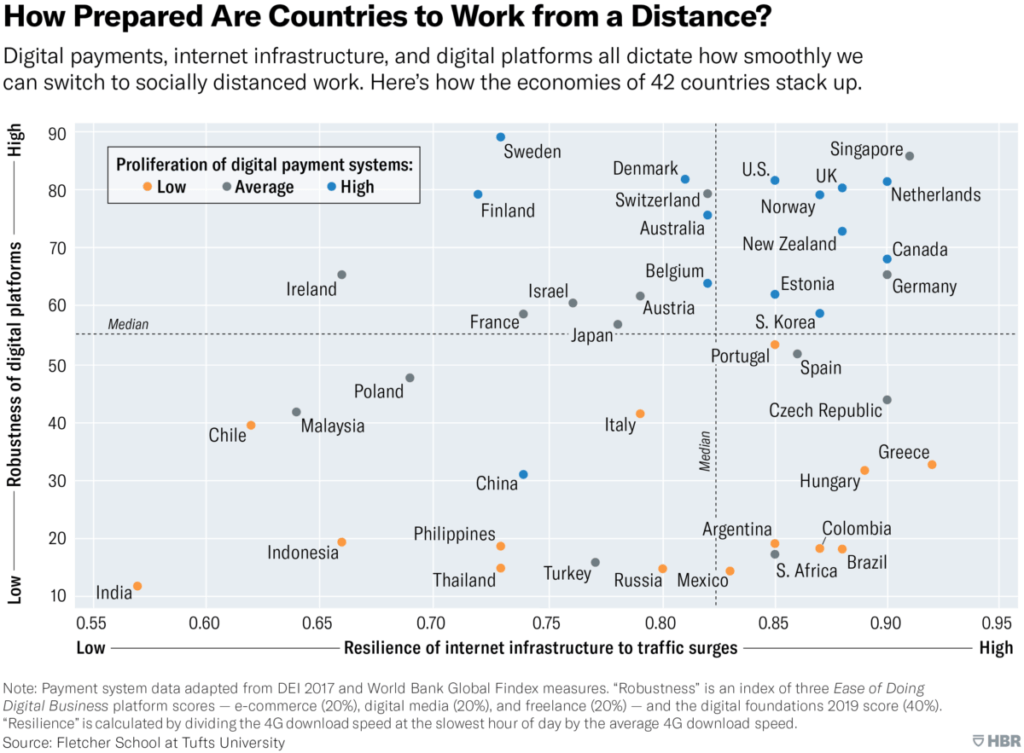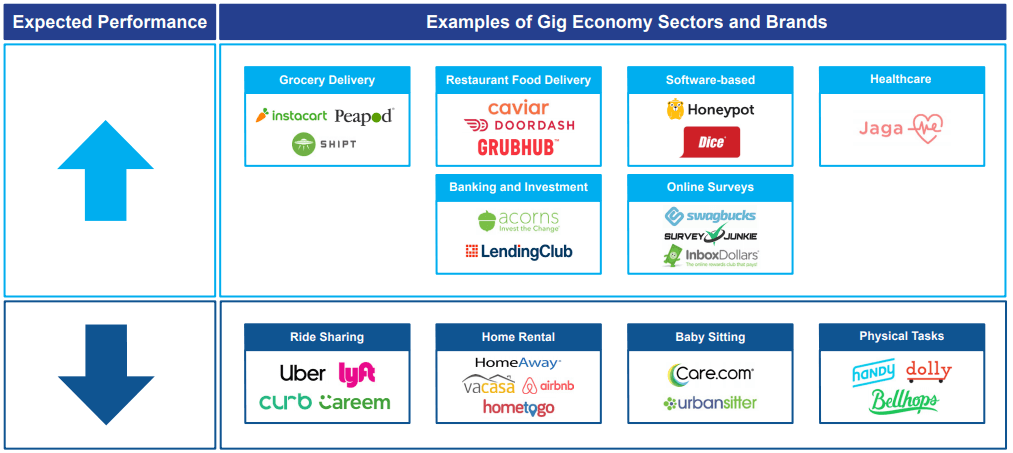Remote work used to be a mere blip on our radar, available to (and desired by) only a minority of the labour force.
Now, more than a year since the COVID-19 outbreak, something that seemed temporary seems likely to stay.
The pandemic accelerated us into a digital economy, making it more necessary than ever to rethink the way we do work.
Here’s the data to back that up, including:
- Statistics on work from home productivity levels
- The pros and cons of working from home (in both quantitative and qualitative data)
- 2020-2021 work from home statistics for Asia
- How ready the world is for remote work, infrastructure-wise
- How the pandemic has impacted the digital gig economy
- The future of work
Read also: What’s the Future of Remote Work in Singapore?
Work from Home Productivity Statistics
1. During the lockdown, knowledge workers spent 12% less time in large (and tedious) meetings and 9% more time interacting with clients and external partners. (Harvard Business Review)
2. The lockdown helped more knowledge workers take responsibility for their own schedules. They reported finishing 50% more work tasks — tasks they chose because they saw the activities as important. (Harvard Business Review)
3. The pandemic helped knowledge workers re-evaluate their priorities, leading them to spend more time on worthwhile activities and less on “tiresome tasks.” The number of tasks rated tiresome dropped from 27% to 12%, and the number of tasks offloaded on others dropped from 41% to 27%. (Harvard Business Review)
4. On the same note, knowledge workers took more control of their work hours during the lockdown. They were 89.5% more likely to make time for work that they viewed as important, and 69.2% less likely to do something that a colleague asked them to. (Harvard Business Review)
5. During the lockdown, knowledge workers reported their work was “more important, less tiresome, less easily delegated, and contribute[d] to the company’s objectives.” They were also more likely to view themselves as important contributors. (Harvard Business Review)
6. 51% of employees report being more productive working from home, while 15% report being less productive. The remainder report that there’s been no difference. (Qualtrics)
7. 55% of managers believe their direct reports have been more productive, while 16% believe they’ve been less productive. (Qualtrics)
8. The lack of a commute, improved focus, flexible schedules, and more privacy were the top reasons cited for improved productivity while working from home. (Qualtrics)
The Pros and Cons of Working from Home
9. Over half of all employees (53%) say their organisation’s purpose resonates with them now more than before the pandemic. (Qualtrics)
10. Employees are twice as likely to say that their personal well-being has improved since the pandemic. (Qualtrics)
11. If everybody able to work from home worldwide did so for just one day a week, it would cut annual global oil consumption by 1% for road passenger transport. Carbon emissions would drop by 24 million tonnes per year. (International Energy Agency)
12. Globally, air pollution from road traffic dropped significantly during the COVID-19 lockdowns. One of the steepest was in New Delhi, which saw a two-thirds reduction in nitrogen dioxide. (International Energy Agency)
13. A typical employer can save roughly $11,000 per year for every person who works remotely half the time. (Global Workplace Analytics)
14. Employees can save between $2,500 and $4,000 a year if they work remotely half the time — and more if they move to a cheaper area and work remotely full-time. (Global Workplace Analytics)
15. Seven in 10 Singaporeans reported that working from home has improved their mental health. (The Straits Times)
Read also: 9 Part Time Jobs You Can Do From Home in Singapore
Work from Home Statistics in Asia
16. 91% of teams in Asia-Pacific have implemented work from home arrangements since the COVID-19 outbreak. (Gartner)
17. Based on the robustness of the country’s digital infrastructure, Singapore and South Korea rank among the countries most prepared for remote work. Indonesia, India, Philippines, and Thailand are among the most ill-prepared. (Harvard Business Review)

18. The ability to work from home is highly correlated with well-paid occupations and the digital infrastructure of the country. For example, only 5.5% of workers in Ghana could work from home compared to 23% in Yunnan, China. (Saltiel, 2020)
19. In Singapore, the most common complaints about working from home include working longer hours, doing work outside their usual hours, distractions from children and family, and the difficulty of convincing their supervisors of their productivity. (The Straits Times)
20. In Malaysia, employees able to work from home were largely in highly-paid sectors such as finance, insurance, science, and communications. These well-compensated jobs totalled less than a third of Malaysia’s workforce in 2019. (London School of Economics)
21. In India, remote work is the norm for housewives looking to supplement their income. Many do data entry or online retail from their homes. Because these are typically low-paying jobs, there’s a stigma against working from home. For Indians, the office is the place of more prestigious and higher-paid work rather than the standard. (Raconteur)
22. Vietnam has a small but growing class of professionals freelancing from home, providing services like computer programming, design, and translation. Young, tech-savvy Vietnamese are leading the charge in more widespread adoption of remote work. (Raconteur)
23. In Indonesia, 40% worked entirely from home during the pandemic. Young tech-savvy professionals, in particular, preferred to return to their hometowns and work remotely instead of living in big cities. (Indonesian Statistics Agency BPS)
24. 38% of Vietnamese reported being productive when working from home, while 16% reported being very productive. Only 8% report not being very productive. This further supports the shifting mentality in favour of remote work. (Statista)
25. 20% of Thai companies have permanently shifted to working from home. (PwC Thailand)
26. Only 35-40% of Filipinos secure a job of any kind after graduation. Barely 10% get a job in the field they studied. Freelance work opens up a world of opportunity for Filipinos, who face high levels of stress from work and daily commutes. (Manila Bulletin, ABS-CBN News)
27. In Singapore, eight in 10 workers prefer to work from home or have flexible employment. Only one in 10 wanted to return to the office full-time. (The Straits Times)
28. Singaporean employees are cautious about returning to the workplace, with most citing the risks of taking public transport, exposure to the virus, and having to wear a mask in the office. (The Straits Times)
The Global Shift to Digital Infrastructure
29. Singapore, Canada, Germany, and the Netherlands are among the highest-rated for the resilience of their internet infrastructure against traffic spikes. (Harvard Business Review)
30. Singapore and the Netherlands also ranked well for the robustness of their digital platforms, though the proliferation of digital payment systems isn’t as high in Singapore. (Harvard Business Review)
31. Comparatively, the United States is decently prepared for work-from-home arrangements, but more work needs to be done on strengthening its infrastructure. Poorer and rural areas tend to have less access to connectivity, while broadband fees are among the highest in the world because of the lack of competition. (Harvard Business Review)
32. India has the least resilient internet infrastructure for handling traffic surges. The proliferation of digital payment systems is also low, but that’s partially because internet penetration isn’t uniform across the country. (Harvard Business Review)
33. China’s use of digital payment systems is widespread thanks to apps such as Weixin/WeChat. However, it does not rank as highly on the resilience of its internet infrastructure and the robustness of digital platforms. This is likely because a substantial percentage of China’s population lives in rural, lower-income regions. (Harvard Business Review)
34. China is investing $3.8 trillion dollars in infrastructure to position itself as a high-tech powerhouse after the pandemic. The investment will cover aspects such as 5G, IoT, big data, artificial intelligence, and innovative infrastructure. (Computer Weekly)
35. Internet penetration in Indonesia is low, but its digital denizens are among the world’s most active. Embracing digitisation can grow the country’s GDP by USD150 billion (10%) by 2025. (McKinsey)
The Rise of the Gig Economy
36. Nine in 10 Singaporean employees believe they need to reskill or upskill to remain competitive in the job market. This belief was particularly prevalent among those aged 56 to 65 years old. (UOB)
37. Almost nine in 10 Singaporeans believe that after the pandemic, companies will prefer candidates who can perform multiple roles or turn to digitisation to reduce costs. (UOB)
38. Two-thirds of major companies use freelancers to lower their labour costs. (Forbes)
39. In March 2020, more than half of gig workers had lost their jobs. The remaining gig economy workers had lost two-thirds of their income. (Fairwork Foundation)
40. During the lockdown, over a quarter of workers in the gig economy reported having more work than usual. (Blundell et al., 2020)
41. The pandemic provided a boost to gig economy sectors such as grocery delivery, restaurant food delivery, banking and investment, software programming, and healthcare. It had a negative effect on ride-sharing, home rentals, babysitting, and jobs requiring physical labour. (KPMG)

42. COVID-19 accelerated the shift to a digital economy, providing a boon to gig and freelance workers. Before the pandemic, the digital gig economy grew steadily at 17% CAGR, reaching 296 billion dollars in 2020. It’s projected to hit 455 billion dollars in 2023. (Mastercard)
43. Analysts project that there will be 915 million freelancers around the world by 2023, an 18.8% increase from the 770 million in 2018. There’s also likely to be 78 million global gig workers by 2023 (+81.4% since 2018). (Mastercard)
Statistics on the Future of Work
44. It’s estimated that around 20% of jobs globally could be done from home. (Boeri et al., Brynjolfsson et al., Eurostat, Saltiel)
45. A majority of CEO respondents expect remote work to have a lasting impact post-pandemic. (PwC CEO Panel Survey)
46. 48% of companies worldwide now have distributed workforces, compared to 30% pre-pandemic. Distributed work means there’s no central location to work remotely from; instead, the entire workforce is distributed around the world. This has significant implications for the future of organisations after the pandemic passes. (Statista)
47. In the UK, 73% of knowledge workers want flexible employment even after the pandemic is over. The average employee wants to work from home for two-thirds of the week and the remaining third in the office. (Claromentis)
48. In Singapore, four in 10 employees want hybrid working arrangements — the ability to split their working hours between home and the office — and a little more than four in 10 want to continue working from home. (The Straits Times)
49. Unfortunately, about five in 10 Singaporean employees feel they would be penalised by their workplaces if they expressed a preference for working from home. (The Straits Times)
50. Thai companies are more likely to outsource work to skilled freelancers with the ongoing pandemic. This will help cut costs and create more flexibility in labour management. (PwC Thailand)
51. 74% of millennials don’t want to go back to the office full-time. 65% of Gen Xers and 58% of baby boomers would also like to continue working from home as much as possible after the pandemic. (Gallup)
52. According to one survey, 53% of its respondents said they would consider staying at their organisations longer if there were a long-term remote work policy. 10% would quit if they were forced back into the office full-time. (Qualtrics)
53. 80% of those looking for new jobs said it was important that their next jobs offered the opportunity to live and work from anywhere. (Qualtrics)
54. 70% of managers prefer hybrid working arrangements compared to 59% of individual contributors. (Qualtrics)
